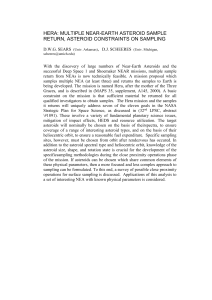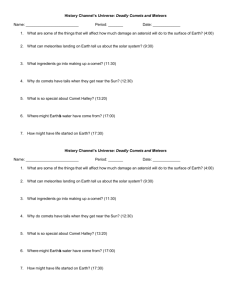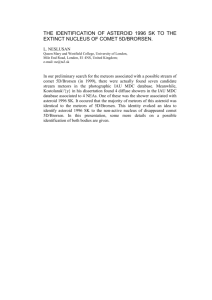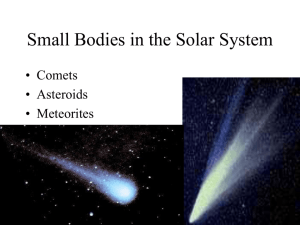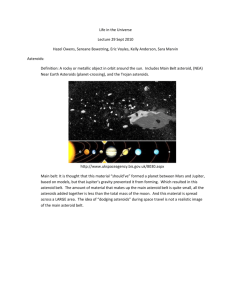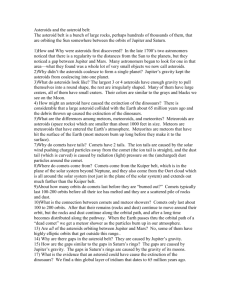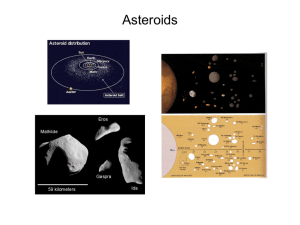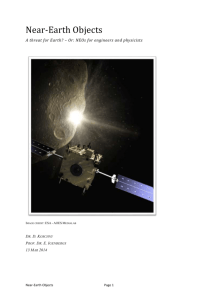Rachel - Science A 2 Z
advertisement
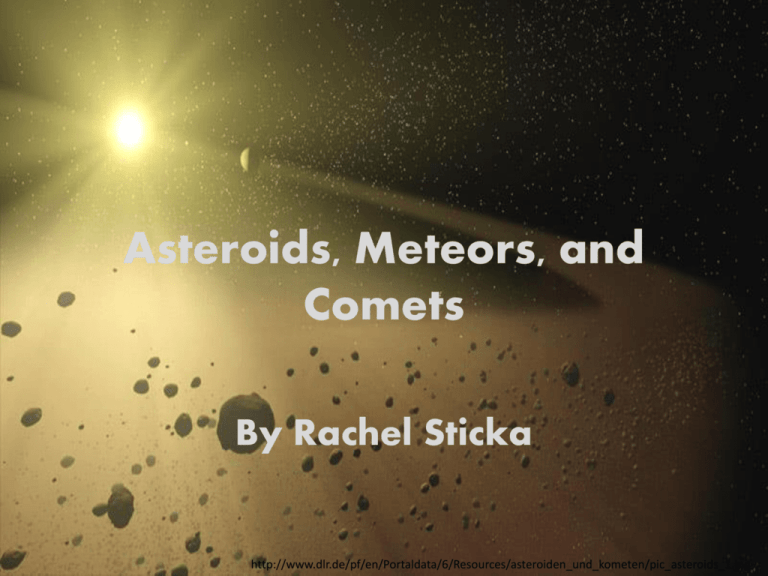
Asteroids, Meteors, and Comets By Rachel Sticka http://www.dlr.de/pf/en/Portaldata/6/Resources/asteroiden_und_kometen/pic_asteroids_1.jpg What are Asteroids, Meteors & Comets? Comets, asteroids, and meteors are often grouped together since they are all basically the same thing: small pieces of rock and/or ice that aren't part of a major planet. http://curious.astro.cornell.edu/comets.php http://www.arcetri.astro.it/irlab/Astro/astromirror/ninepla nets/pics/compare4.jpg http://www.wallpapers-free.org/49/-/Asteroid_belt_in_orbit/ Asteroids • The largest asteroid is Ceres, which is 933 kilometers (580 miles) across. http://www.wallpapers-free.org/49/-/Asteroid_belt_in_orbit/ • • • A relatively small, inactive, rocky body which orbits the sun. C-type, 75% of known asteroids: extremely dark , approximately the same chemical composition as the Sun minus hydrogen, helium and other volatiles. S-type, 17%: relatively bright , composed of metallic nickeliron mixed with iron- and magnesium-silicates; M-type, most of the rest: bright, composed of pure nickel-iron. There are also a dozen or so other rare types. http://www.nineplanets.org/asteroids.html http://neo.jpl.nasa.gov/faq/#diff http://curious.astro.cornell.edu/comets.php Meteors, Meteoroids, and Meteorites What is a Meteor? • The light phenomena which results when a meteoroid enters the Earth's atmosphere and vaporizes. Also known as a shooting star. What is a Meteorite? • A Meteoroid that has landed on Earth’s surface. What is a Meteoroid? • A small particle from a comet or an asteroid orbiting the Sun. http://neo.jpl.nasa.gov/faq/#diff http://www.wallpapers-free.org/49//Asteroid_belt_in_orbit/ Comets A relatively small, at times active, object whose ices can vaporize in sunlight forming an atmosphere (coma) of dust and gas and, sometimes, a tail of dust and/or gas. http://upload.wikimedia.org/wikipedia/commons/1/18/Come t-Hale-Bopp-29-03-1997.jpeg http://neo.jpl.nasa.gov/faq/#diff http://www.wallpapers-free.org/49/-/Asteroid_belt_in_orbit/ Some Interesting Facts • Many asteroids, including all of the largest asteroids, orbit the sun between Mars and Jupiter in the Asteroid Belt. • Meteors are the short, white trails across the sky that we call "shooting stars." • Comets come from two places in the Solar System: the Oort Cloud and the Kuiper Belt. http://www.wallpapers-free.org/49/-/Asteroid_belt_in_orbit/ http://curious.astro.cornell.edu/comets.php What If? Close your eyes. Think about how an asteroid might look floating through space. What is the shape? Is it sparkly? Dull? Filled with delicious minerals? Does it have craters? Now imagine that you are a scientist who has discovered a huge asteroid hurtling through space. Create a 3-D model of the new asteroid, then draw and label your model on a separate piece of paper. Be sure to name your new discovery!!! http://cdn.physorg.com/newman/gfx/news/hires/asteroid2867.jpg Create Your Own Asteroid!!! • • • • • • Directions: Get into groups of 5 or 6. Have one person from each group collect materials from the list. PUT ON FOOD GLOVES!!! Mix dough, be sure to follow the recipe. Divide dough into a ball for each person. Individually, add your own food “minerals” to create your own asteroid! • Minerals to Add: Iron-silicate: Chocolate chips or Raisins. Magnesium-silicate: Rice Crispies or vanilla chips or oatmeal. Metallic-iron: Rainbow sprinkles or edible glitter. • After your asteroid is complete: Create a picture of your asteroid, labeling the different minerals, if it has any craters and don’t forget to name it. http://www.enchantedlearning.com/subjects/astronomy/asteroids/composition.shtml http://www.wallpapers-free.org/49/-/Asteroid_belt_in_orbit/
